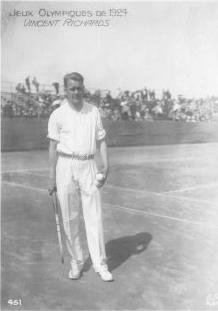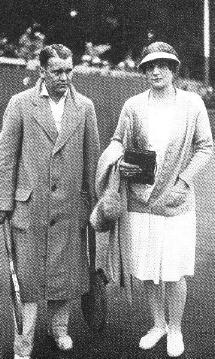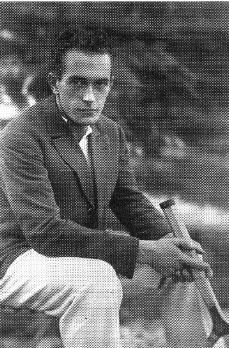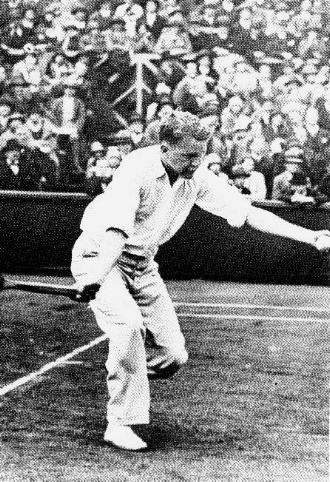
Vincent Richards |
Champion Vincent Richards
|
| 1924 was to be the last year that tennis was played at the Olympic Games before seeing a break with the international movement for over 60 years. The sport would have to wait until the games of 1984 to re-establish itself, firstly on a demonstration level and then finally as a fully-fledged Olympic Sport again in 1988. The year before, in 1923, the International Tennis Federation had also obliged all of the major European championships to drop the term “World” from their titles in order to appease the Americans and to place all of the principal tournaments, in particular Wimbledon and Forest Hills, on a more equal footing (Refer to “The Last World Clay Court Championships”) |

Vincent Richards and Helen Wills |
The
crowd at the last World Clay Court Championships in Paris in 1923 had marvelled
at the skills of the American William Johnston. The Olympic Games of 1924
were also staged in Paris but now it was two new rising stars, Vincent
Richards and Helen Wills, who were to make their impression.
“Vinnie” Richards was 21 years old. He had trained with and shown himself to be one of the most gifted students of the great Bill Tilden. He arrived in Paris already an experienced player, having won the doubles title at Forest Hills with his mentor Tilden in 1918 at the ripe old age of 15. He had also played and won several doubles matches in the Davis Cup in partnership with Williams. Indeed, he’d only been excluded from success in singles at this point in time by the presence of the two Bills, Tilden and Johnston, on the tournament circuit. Richards came to Paris in 1924 with the American Olympic team to demonstrate the continued supremacy of American tennis. His partner in the men’s doubles was Frank Hunter, another bright prospect for the future. Frank had reached the singles finals at Wimbledon the previous year. Helen Wills was 18 years old. She too was already an established competitor. She had won the singles at Forest Hills in 1923 and was now seen as a very credible contender to the world number one Suzanne Lenglen. |
| The
other members of the American team were less known: Dick Williams would
play the mixed doubles with Hazel Wighman, who, whilst a good player, is
primarily be remembered for her husband’s creation the Wighman Cup some
years later. This is a women’s team trophy between Great Britain and the
USA.Hazel would play the women’s doubles with Helen Wills. Finally, Vincent
Richards’ partner at mixed doubles was the total newcomer Marion Jessop.
Only the French could mount any form of credible resistance at the games against such a strong American challenge. Their players included Suzanne Lenglen who had been Wimbledon Singles Champion since 1919, Henri Cochet, World Clay Court Champion in 1922, Jean Barota who had only just recently won the Wimbledon title, a young Rene Lacoste and the 29 year old Toto Brugnon. Unfortunately, the big and
keenly awaited confrontation between the French world number one and Helen
Wills was not to be. Suzanne Lenglen fell ill before the games and had
to withdraw. This also deprived her partner Henri Cochet a shot at a very
probable gold medal in the mixed doubles.
|

Henri Cochet in 1924 |

Vincent Richards, Paris, 1924 |
The
Americans walked away with a grand slam and with Vincent Richards a memorable
hero of the games. He won two gold medals and one silver and left a well
prepared Henri Cochet with one of the biggest disappointments of his life.
Henri would later relate in his memoires: “ I was in excellent physical
condition and reached the final by beating Jean Barota in the semis. I
then went down in five sets to an inspired Vincent Richards. At the beginning
of the fifth set the French team captain Decugis plunged an enormous sponge
into a bucket of iced water and then splashed it down on the back of my
head. I was simply too exhausted to respond however”.
It was the same outcome in the men’s doubles where Richards and Hunter beat Cochet and Brugnon in five sets; 4/6, 6/2, 6/3, 2/6, 6/3. As for Helen Wills, in the absence of Suzanne Lenglen, nobody could match her. She won gold medals in both the singles and the doubles. Finally, Vincent Richards won his third and silver medal with Marion Jessop losing to Wighman and Williams in the final of the mixed doubles. |
|
|
|
|
|
|
|
|
|
Athènes |
|
|
|
|
|
|
Paris |
(U.K.) |
((U.K.) |
(U.K.) |
R.Doherty (U.K.) |
|
|
St-Louis |
|
|
(U.S.A.) |
|
|
|
Londres Out door |
|
(U.K.) |
R.Doherty (U.K.) |
|
|
|
Londres In door |
|
|
H.Barret (G.B.) |
|
|
|
Stockholm |
|
|
H.Winslow (S.Afr) |
H.Schomburgk (Ger.) |
|
|
Stockholm In door |
|
(U.K.) |
M.Germot (Fr.) |
C.Dixon (U.K.) |
|
|
Anvers |
|
|
M.Woosnam(U.K.) |
.Decugis (Fr.) |
W.McNair (U.K.) |
|
Paris |
|
|
(USA) |
R.Williams (USA) |
H.Wightman (USA) |
Previous
story : 1923, Little Bill Johnston and the end of the early World Clay
Court Championships
Next
story : 1922-1926 The beginning of the french Musketeers adventure
Des idées, des remarques, des suggestions? E-mail
E-mail
Dernière mise à jour : 22
Octobre 2001
Copyright BLANCHE NET communications.
Mars 2000.